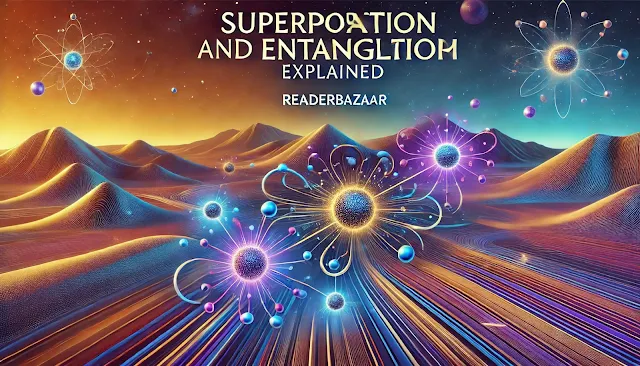Superposition and Entanglement Explained
Introduction
In the fascinating world of quantum mechanics, two concepts stand out as revolutionary: superposition and entanglement. These phenomena form the backbone of quantum computing and other advanced technologies. In this post, we will unravel these complex ideas, their pros and cons, and their applications. Welcome to Reader Bazaar, your trusted resource for all things quantum and beyond.
Table of Contents
- What is Superposition?
- What is Entanglement?
- Pros and Cons of Superposition and Entanglement
- Relation Between Superposition and Entanglement
- Differences Between Superposition and Entanglement
- Examples and Case Studies
- Comparative Analysis
- FAQs About Superposition and Entanglement
- Conclusion
- References
What is Superposition?
Superposition refers to the ability of a quantum system to exist in multiple states simultaneously until measured. This principle allows quantum computers to process vast amounts of data in parallel, a feat impossible for classical computers.
Keywords: quantum superposition, quantum mechanics basics, quantum computing potential
What is Entanglement?
Quantum entanglement occurs when two or more particles become interconnected, such that the state of one particle instantly influences the state of the other(s), no matter the distance between them. This "spooky action at a distance," as Einstein called it, is fundamental to quantum communication and cryptography.
Keywords: quantum entanglement, quantum cryptography, quantum communication
Pros and Cons of Superposition and Entanglement
Pros:
- Superposition enables exponential computational power in quantum computing.
- Entanglement allows secure communication via quantum encryption.
- Potential applications in solving real-world problems, from drug discovery to optimization.
Cons:
- Fragility: Both phenomena are easily disturbed by environmental noise.
- Complex implementation due to the need for highly controlled environments.
- Ethical concerns in the context of cryptographic applications.
Relation Between Superposition and Entanglement
Superposition and entanglement are interrelated principles of quantum mechanics. While superposition describes the probabilistic nature of a quantum system, entanglement demonstrates how systems can share states and influence one another, amplifying their collective potential in computational tasks.
Differences Between Superposition and Entanglement
| Feature | Superposition | Entanglement |
|---|---|---|
| Definition | A single particle exists in multiple states simultaneously. | Two or more particles share a quantum state. |
| Dependency | Independent phenomenon. | Requires two or more particles. |
| Applications | Quantum computing, quantum simulations. | Quantum cryptography, quantum teleportation. |
| Key Challenge | Maintaining coherence. | Ensuring long-distance entanglement. |
Examples and Case Studies
Superposition Example: Quantum bits (qubits) in quantum computers can represent 0 and 1 simultaneously, allowing faster problem-solving.
Entanglement Example: Quantum entangled photons enable secure communication in quantum key distribution.
Case Study:
Google’s quantum computer, Sycamore, demonstrated quantum supremacy by solving a complex problem in 200 seconds—a task that would take classical computers thousands of years.
Comparative Analysis
Superposition offers incredible computational advantages by enabling parallel processing, while entanglement ensures unparalleled security in data transmission. Together, these phenomena push the boundaries of technological innovation.
FAQs About Superposition and Entanglement
- What is the significance of superposition in quantum computing? Superposition allows qubits to process exponentially more information compared to classical bits.
- How is entanglement used in real-world applications? Entanglement is foundational for quantum encryption and teleportation.
- Are superposition and entanglement interconnected? Yes, entanglement often relies on superposed states to achieve quantum coherence.
Conclusion
Superposition and entanglement are the pillars of quantum mechanics, opening doors to unprecedented technological advancements. Whether you are a tech enthusiast, a student, or a professional, understanding these concepts is crucial for navigating the quantum era. Stay tuned to Reader Bazaar for more insights into the world of quantum science.
References
- Nielsen, M. A., & Chuang, I. L. (2010). Quantum Computation and Quantum Information.
- Preskill, J. (2018). Quantum Computing in the NISQ Era and Beyond.
- Google AI Blog - Quantum Supremacy Using a Programmable Superconducting Processor.
Call-to-Action (CTA)
Are you ready to dive deeper into quantum mechanics? Explore more fascinating articles on Reader Bazaar! Share this post with friends and join the conversation. Subscribe to our newsletter for weekly updates!




0 Comments